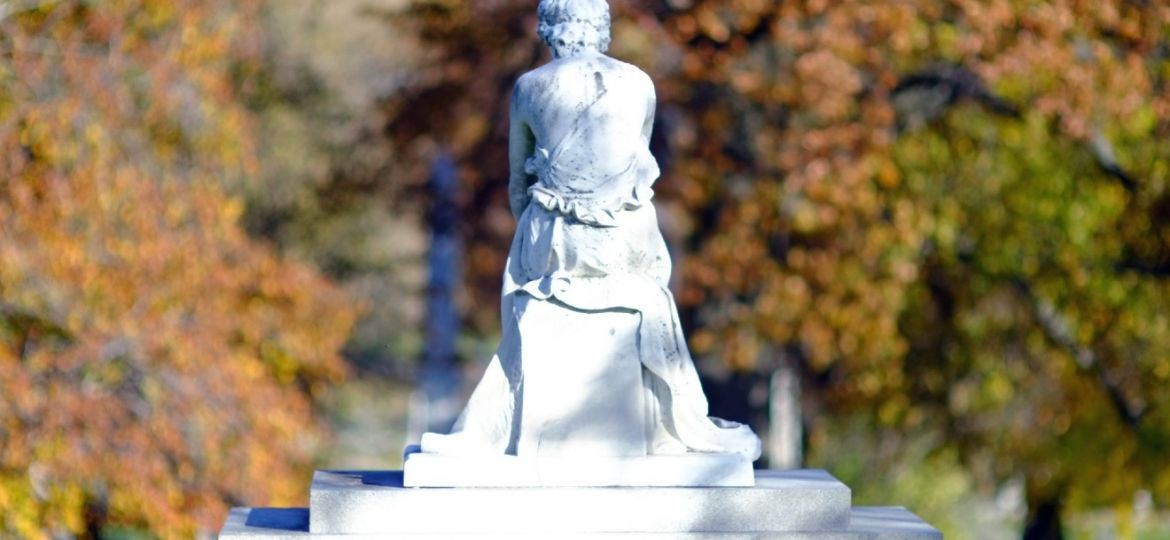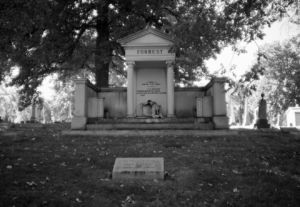
They are the templates for bold and fearless, the breakers of glass ceilings, the badass women of yore. They’re in the ground, at Crown Hill Cemetery. They’re receiving visitors. Stop by.
Her famous brother’s muse: Alice V. Adams (1917-1958) Section 66, Lot 453
Alice Adams was the writer Kurt Vonnegut’s muse, and his sister, older by five years. When her brother sat down to write, she was his audience of one. From his 1976 novel “Slapstick”: “I had never told her so, but she was the person I had always written for. She was the secret of whatever artistic unity I had ever achieved.”
Adams died of cancer two days after her husband was killed in a train wreck. Vonnegut and his wife adopted their children.
“Paddling her own canoe:” Sarah Bolton (1814-1893) Section 5, Lot 17
During Indiana’s constitutional convention of 1850, Sarah Bolton worked to ensure independent property rights for women, a radical notion in that day.
She visited the great cathedrals of Europe – and was disgusted. She noticed the “wasted forms and hungry faces” of the cleaning ladies and “wondered if the money expended on the tombs of these princes and prelates might not have been better invested for the benefit of the poor.”
Bolton was also a famous poet, best known for “Paddle Your Own Canoe,” a paean to self-reliance. Here’s the first stanza:
“Voyager upon life’s sea/To yourself be true/And whatever your lot may be/Paddle your own canoe.”
They danced ‘til they dropped: Virtue Hampton (1922-2007) Section ABBY, Lot B-6-D; and Aletra Hampton (1915-2007) Section 212, Lot 316.
 The Hampton family was surely Indianapolis’ most celebrated musical family. Parents Clark and Laura, and their 12 children, became a fixture in Indianapolis’ jazz clubs along Indiana Avenue. In the 1940s, when most of their brothers were drafted into the military, sisters Aletra, Virtue, Carmelita, and Dawn formed the rhythm and blues group known as the Hampton Sisters. They split up in the 1950s, with Dawn moving to New York to pursue cabaret and Carmelita taking a post office job in Chicago.
The Hampton family was surely Indianapolis’ most celebrated musical family. Parents Clark and Laura, and their 12 children, became a fixture in Indianapolis’ jazz clubs along Indiana Avenue. In the 1940s, when most of their brothers were drafted into the military, sisters Aletra, Virtue, Carmelita, and Dawn formed the rhythm and blues group known as the Hampton Sisters. They split up in the 1950s, with Dawn moving to New York to pursue cabaret and Carmelita taking a post office job in Chicago.
Aletra, who played piano and sang, and Virtue, a bassist, remained in Indy. They performed together until 2006. Virtue died in January 2007, and Aletra 10 months later.
Palmist to the stars: Nellie Simmons Meier (1862-1944) Section 39, Lot 470
Nellie Meier was 4-feet, 7-inches tall, and, by her own account spent her girlhood as a wallflower. “I didn’t like it that way, I wanted to be more than that,” Meier said years later, after she was famous, in a newspaper interview.
Her fame came from her skill at palm reading. Celebrities of all stripes—actors, politicians, tycoons—came to her house in Indianapolis, called Tuckaway, so she could look at their upturned hands and deduce their “character traits.” Among her customers: Margaret Sanger, Elsie de Wolf, Amelia Earhart, Mary Pickford, George Gershwin, and Albert Einstein.
“Behind the scenes she may have been calculating, but in person she was famously delightful.”
On a first-name basis with the people: Julia May Carson (1938–2007) Section 78, Lot 172
Julia Carson represented Indianapolis in the U.S. Congress from 1997 until her death (the first woman and the first African American to do so), but more than that she was the foremost political power broker in Center Township for a quarter century, from the 1980s until her passing in 2007. Louis Farrakhan, along with 2,000 other people, attended her four-hour funeral.
Behind the scenes she may have been calculating, but in person she was famously delightful.
“She’d walk up to somebody and even if she didn’t know them, she appeared to, and they responded as if they knew her,” pollster Brian Vargus once told IndyStar. “And this was not just political savvy; it was, for want of a better term, ‘street smarts.’ “
A brainiac who died young, and was deeply mourned: Albertina Forrest (1870-1904) Section 25, Lot 230
 At a time when few women even went to college, Forrest had a Ph.D. She taught philosophy and education at Butler University and wrote about serious, weighty matters. She was just 29 when she read aloud her treatise “The Cry, ‘Back to Christ’: Its Implication” to an august, nearly all-male audience at the University of Chicago. The piece was such a hit, it stayed fresh even after its author died of a cerebral hemorrhage. It was published in the American Journal of Theology in 1907.
At a time when few women even went to college, Forrest had a Ph.D. She taught philosophy and education at Butler University and wrote about serious, weighty matters. She was just 29 when she read aloud her treatise “The Cry, ‘Back to Christ’: Its Implication” to an august, nearly all-male audience at the University of Chicago. The piece was such a hit, it stayed fresh even after its author died of a cerebral hemorrhage. It was published in the American Journal of Theology in 1907.
Forrest must have been a wonderful wife, too, because her husband went all out on her monument. It’s about the fanciest in the whole cemetery, basically a miniature Greek temple.
Stay-at-home-mom-turned-business-tycoon: Edna Balz Lacy (1906-1991) Section C, Lot D-6
Edna Lacy was a stay-at-home mom when her husband, Howard John Lacy II, died unexpectedly in 1959. Suddenly she had a large company to run.
Lacy quickly proved herself to be boardroom-level savvy. Under her leadership U.S. Corrugated-Fibre Box Co. diversified into a wide range of fields—video-tape distribution and motorcycle parts, among several others. Those fields were lucrative. By the time Edna Lacy died, Lacy Diversified Industries Inc. had 1,900 employees.
“Mary, take it easy on him.”“Mother, I will not,” she said.
Suffering the slings and arrows and saying “So what”: Mary Boyd Higgins (1925-2019) Section 45, Lot 21 (ashes scattered in family plot)
Higgins eschewed a privileged, unsatisfying life in Indianapolis for a bruising, satisfying life in New York as trustee of the Wilhelm Reich Infant Trust. Long after Reich’s death she kept the radical and widely loathed psychoanalyst’s work alive, publishing (through Farrar, Straus and Giroux) 11 volumes of Reich’s work between 1959 and 2008. She organized seminars that promoted scholarly study of Reich, a virulent anti-fascist who believed much of the world’s woes were due to people repressing their sexuality. Higgins believed it, too.
Reich died in prison in 1957, having been persecuted and mocked by the U.S. government and the medical establishment. As his surrogate, Higgins withstood similar attacks. “So what,” she once said.
Higgins never married. She was an expert tennis player even as a teenager, and once as she headed out the door to play a match with a male suitor, her mother pleaded, “Mary, take it easy on him.”
“Mother, I will not,” she said.
Featured image courtesy of Daniel Incandela.
Hamptons sisters image courtesy of the Indiana Historical Society, P0233





